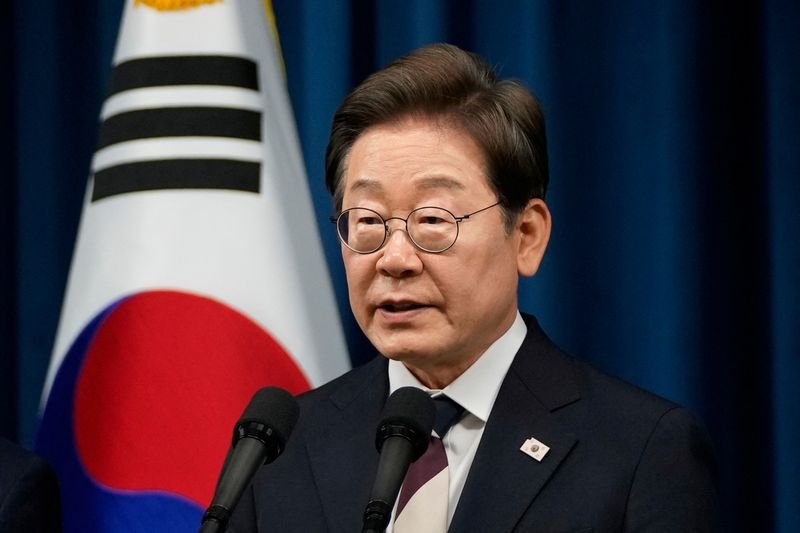Tools & Platforms
South Korea makes AI investment a top policy priority to support flagging growth

By Jihoon Lee
SEOUL (Reuters) -South Korea vowed on Friday to make investment in artificial intelligence a top policy priority, as the government slashed its economic growth projection for this year due to trade headwinds caused by U.S. tariffs.
In the first bi-annual economic policy plan under President Lee Jae Myung’s new administration, the finance ministry said it would introduce from the second half of 2025 policy packages for 30 major AI and innovation projects.
These include AI technologies for robots, cars, ships, home appliances, drones, factories and chips, as well as advanced materials and cultural products such as “K-beauty” and “K-food”.
“A grand transformation into AI is the only way out of growth declines resulting from a population shock,” the ministry said in a statement, referring to South Korea’s record low birthrate.
While the government plans to include measures such as financial investments, tax incentives and regulatory improvements in the packages, it said it would also create a 100 trillion won ($71.56 billion) fund, jointly with the private sector, to invest in strategic sectors.
The policy plans aim to make the country one of the world’s top three AI powers and boost potential economic growth rates in a country with the world’s lowest birth rate, the ministry said.
South Korea’s potential growth rate is estimated at around 2% and expected to fall below 1% by the late 2040s, though the government hopes the new policies can lift the rate to 3%.
Asia’s fourth-largest economy grew in the second quarter at the fastest pace in more than a year, as consumer demand rebounded and technology exports remained robust, but still faces trade uncertainties due to higher U.S. tariffs.
Last month, South Korea agreed to a U.S. trade deal that reduces tariffs on the Asian ally to 15% from a threatened 25%, but still higher than the baseline 10% that had been in place.
The finance ministry expects the export-reliant economy to grow 0.9% this year, down sharply from the 2.0% expansion last year and its previous projection of 1.8% in January. The economy is expected to grow 1.8% in 2026, the ministry said.
Exports are forecast to grow 0.2% in 2025, but fall 0.5% in 2026, according to the ministry. In 2024, exports jumped 8.1%.
Lee’s liberal administration said it would increase government budget spending for next year at a higher rate than this year, emphasising its proactive fiscal policy stance.
Other major policy plans announced on Friday include support measures for childcare and work-life balance, stronger sanctions to prevent industrial accidents, regulatory frameworks for digital assets and capital market reforms to win a developed-market designation from a global stock index provider.
($1 = 1,397.5000 won)
(Reporting by Jihoon LeeEditing by Ed Davies)
Tools & Platforms
Samsung Tackles Chip Challenges with AI Investments and Foldable Tech

In the rapidly evolving world of semiconductors, Samsung Electronics Co. is navigating a complex web of challenges and opportunities as it heads into the latter half of 2025. The South Korean tech giant, a key player in memory chips and foundry services, has been grappling with supply chain disruptions and intense competition from rivals like TSMC and Intel. According to a recent report from Samsung Securities, the company faces difficulties in upward earnings revisions for general-purpose semiconductors due to ongoing production controls aimed at accelerating cycle recovery. This caution stems from uncertain capital expenditure (Capex) and utilization rate forecasts, which investors are watching closely for signs of a bottom-out.
Samsung’s strategic investments, however, signal a bold push forward. The company recently held a tool-in ceremony for its new semiconductor R&D complex, NRD-K, set to begin operations this year, with plans to pour about 20 trillion won ($14.8 billion) into advanced R&D by 2030, as detailed in the Samsung Global Newsroom. This move is part of a broader effort to bolster AI-driven semiconductors, where Samsung sees higher earnings visibility amid the global AI boom.
Investors Eye AI as Samsung’s Lifeline Amid Market Pressures
First-quarter 2025 results underscored both strengths and vulnerabilities, with Samsung reporting revenue of 79.14 trillion won and operating profit of 6.7 trillion won, per the company’s own announcements in the Samsung Global Newsroom. Yet, shareholders have pressed for growth strategies, leading CEO Kyung Kye-hyun to hint at pursuing major mergers and acquisitions this year to counter underperformance in tech stocks, as covered by Reuters. The failure to fully capitalize on AI has been a sore point, with Samsung’s foundry business posting losses of $3.6 billion in the first half of the year, though a $16.5 billion deal with Tesla for AI chips starting in 2027 offers a glimmer of hope, according to posts circulating on X from industry analysts.
Beyond semiconductors, Samsung is innovating in consumer devices to diversify revenue. The foldable smartphone segment is heating up, with the company planning to strengthen its lineup, including the rumored Galaxy G-Fold tri-fold phone slated for a late-2025 launch, as revealed in leaks reported by Geeky Gadgets. This comes amid growing competition from Huawei and Google, with market overviews from Coherent Market Insights forecasting robust industry growth through 2032.
Strategic Shifts in Foundry and Packaging Technologies
Samsung’s ambitions extend to advanced packaging, where it’s exploring Intel’s hybrid bonding technology to enhance chip density and efficiency, as noted in recent X posts from tech enthusiasts like Techo Vedas. This could position Samsung better against TSMC, whose 2nm process is eyeing mass production in Q4 2025 with a monthly capacity of 100,000 wafers by 2026, according to semiconductor news aggregated on X by inni world. Meanwhile, Samsung’s own 2nm advancements are crucial for reclaiming market share, especially as global wafer foundry revenue surged 14.6% to $41.7 billion in Q2, with TSMC dominating over 70% of the market.
The company’s mobile division is also adapting, with expectations for a delayed flagship processor launch and expanded Galaxy AI features across premium devices, as outlined in X updates from insider Anthony. Price increases for components and a focus on thinner, redesigned foldables aim to counter Apple’s rumored 2026 entry into the foldable arena, per Business Insider.
Geopolitical Tensions and Supply Chain Resilience
Geopolitical factors add another layer of complexity. China’s record chip exports of $89.85 billion in the first seven months of 2024, despite U.S. sanctions, highlight shifting dynamics that could pressure Samsung, as discussed in X posts by Barrett. Samsung’s response includes bolstering domestic capabilities, such as the joint task force for a Galaxy-only chip by 2025, echoing earlier strategies reported in X threads from Anthony dating back to 2022.
Looking ahead, Samsung’s semiconductor outlook hinges on AI recovery evidence, with traditional equipment investments poised to rebound once cycle improvements materialize, per the Sourceability analysis. The resolution of excess inventory is paving the way for growth, but challenges like Intel’s Arrow Lake setbacks and Huawei’s R&D surges, as per X semiconductor news from inni world, underscore the need for agility.
Innovation Beyond Chips: Foldables and Emerging Tech
In foldables, Samsung’s Galaxy Z Fold 7 and Flip models are stacking up well against competitors like Motorola and Google, with expert reviews from ZDNet praising next-gen features. The tri-fold Galaxy G-Fold, detailed in Gadget Hacks, promises to redefine multitasking with its expansive
Tools & Platforms
[News] TSMC Partners with Technical University of Munich to Establish AI Chip R&D Center in Bavaria

According to Liberty Times, citing German media outlet BR24, the Bavarian state government has announced a collaboration with TSMC to establish an AI chip research and development center at the Technical University of Munich (TUM).
The center, officially named the Munich Advanced-Technology Center for High-Tech AI Chips (MACHT-AI), will be led by Professor Hussam Amrouch of TUM. As the report indicates, the move deepens cooperation with TSMC and seeks to strengthen Europe’s chip design capabilities.
The report notes that funding for the AI chip R&D center will come jointly from Bavaria’s Ministry of Science and Ministry of Economic Affairs, with a total budget of about EUR 4.5 million.
For this AI chip center, the report highlights that TSMC will provide technical support, focusing on the development of high-performance, customizable AI chips, while also training students and researchers in manufacturing processes such as FinFET.
As the report mentions, in May TSMC announced at the Europe Technology Symposium that it would establish a chip design center in Munich to help European customers develop high-performance chips for automotive, artificial intelligence, and industrial IoT applications, with operations slated to begin in the third quarter of this year.
eeNews Europe indicates that TSMC’s decision to set up a chip design center in Europe may have been motivated by the region’s shortage of advanced design expertise and the need to provide close support for customers in maximizing the value of the wafer fab it is building in Dresden.
In August 2024, ESMC—TSMC’s joint venture with Bosch, Infineon, and NXP—broke ground in Dresden on what will be the EU’s first FinFET-capable pure-play foundry. When fully operational, ESMC is expected to produce 40,000 300mm (12-inch) wafers per month on TSMC’s 28/22nm planar CMOS and 16/12nm FinFET process technologies, as its press release indicates.
Read more
(Photo credit: TSMC)
Please note that this article cites information from Liberty Times, BR24, the Bavarian state government, eeNews Europe, and TSMC.
Tools & Platforms
Tech CEO lets employees cancel meetings to experiment with AI

But the number of qualified candidates is falling short, according to the report, with the supply of such talent only reaching less than 645,000 in the next two years in the US.
Sarah Elk, Americas head of AI, Insights, and Solutions at Bain & Company, previously noted that executives see the AI talent gap as a major roadblock to innovation.
“Companies navigating this increasingly competitive hiring landscape need to take action now, upskilling existing teams, expanding hiring strategies, and rethinking ways to attract and retain AI talent,” Elk said in a previous statement.
-

 Business4 days ago
Business4 days agoThe Guardian view on Trump and the Fed: independence is no substitute for accountability | Editorial
-
Tools & Platforms3 weeks ago
Building Trust in Military AI Starts with Opening the Black Box – War on the Rocks
-

 Ethics & Policy1 month ago
Ethics & Policy1 month agoSDAIA Supports Saudi Arabia’s Leadership in Shaping Global AI Ethics, Policy, and Research – وكالة الأنباء السعودية
-

 Events & Conferences3 months ago
Events & Conferences3 months agoJourney to 1000 models: Scaling Instagram’s recommendation system
-

 Jobs & Careers2 months ago
Jobs & Careers2 months agoMumbai-based Perplexity Alternative Has 60k+ Users Without Funding
-

 Funding & Business2 months ago
Funding & Business2 months agoKayak and Expedia race to build AI travel agents that turn social posts into itineraries
-

 Education2 months ago
Education2 months agoVEX Robotics launches AI-powered classroom robotics system
-

 Podcasts & Talks2 months ago
Podcasts & Talks2 months agoHappy 4th of July! 🎆 Made with Veo 3 in Gemini
-

 Education2 months ago
Education2 months agoAERDF highlights the latest PreK-12 discoveries and inventions
-

 Podcasts & Talks2 months ago
Podcasts & Talks2 months agoOpenAI 🤝 @teamganassi


















